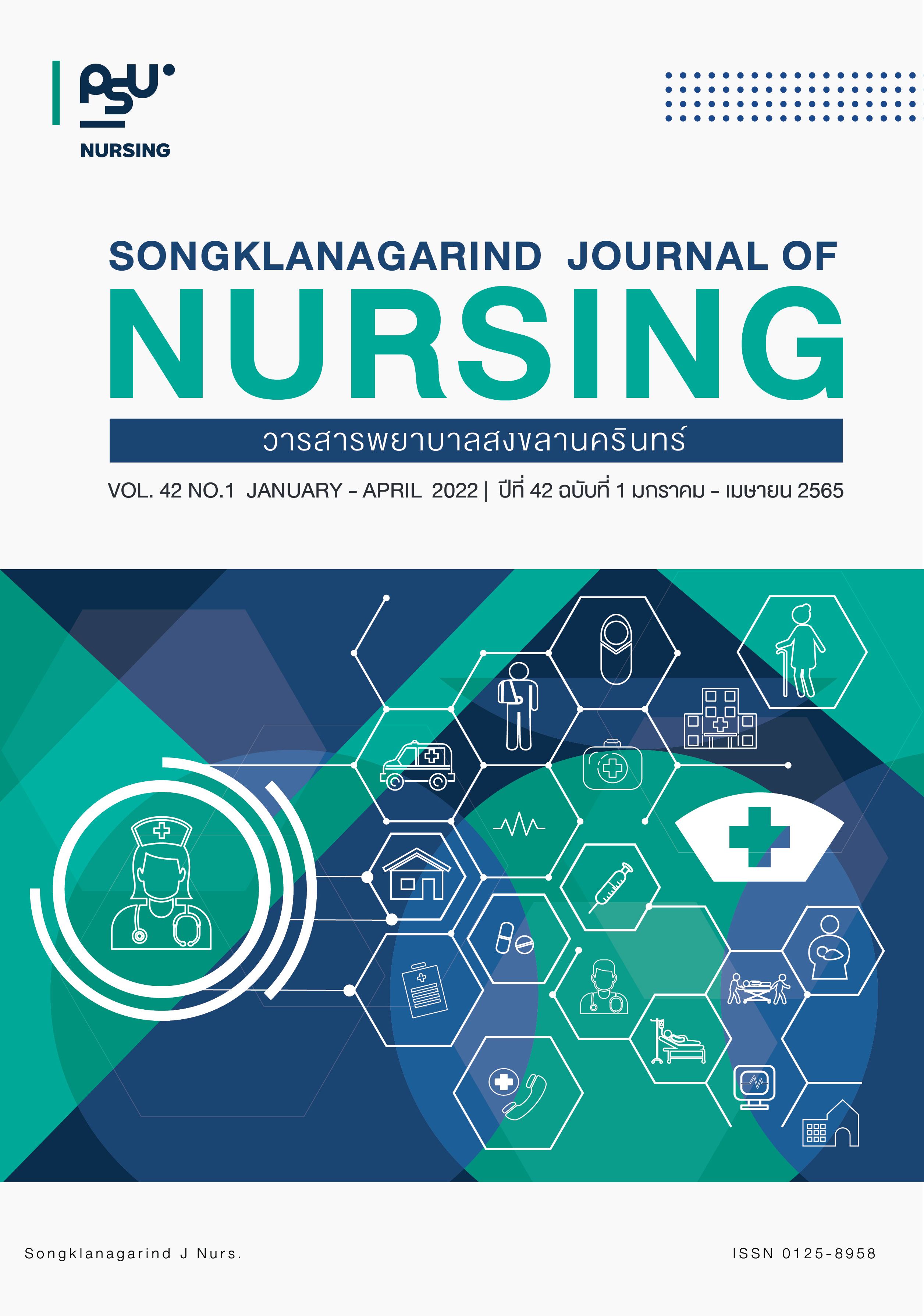ปัจจัยทำนายความผูกพันในงานของพยาบาลวิชาชีพเจนเนอเรชั่นวาย โรงพยาบาลตติยภูมิภาคใต้
Main Article Content
บทคัดย่อ
วัตถุประสงค์: การวิจัยนี้มีวัตถุประสงค์ เพื่อศึกษาระดับความผูกพันในงานของพยาบาลวิชาชีพเจนเนอเรชั่นวาย และศึกษาปัจจัยทำนายความผูกพันในงานของพยาบาลวิชาชีพเจนเนอเรชั่นวาย โรงพยาบาลตติยภูมิภาคใต้ วิธีการวิจัย: กลุ่มตัวอย่าง คือ พยาบาลวิชาชีพกลุ่มเจนเนอเรชั่นวายที่ปฏิบัติงานในโรงพยาบาลตติยภูมิภาคใต้ จำนวน 148 ราย เก็บรวบรวมข้อมูลโดยใช้แบบสอบถาม 1 ชุด 4 ส่วน ประกอบด้วย 1) แบบสอบถามข้อมูลส่วนบุคคล 2) แบบสอบถามความผูกพันในงาน 3) แบบสอบถามภาวะผู้นำการเปลี่ยนแปลงของหัวหน้าหอผู้ป่วย และ 4) แบบสอบถามสภาพแวดล้อมการปฏิบัติที่ดีแบบสอบถามตอนที่ 2 3 และ 4 มีค่าความตรงเชิงเนื้อหาเท่ากับ .87 .82 และ .92 มีค่าความเที่ยงจากการหาค่าสัมประสิทธิ์อัลฟ่าของครอนบาค เท่ากับ .93 .96 และ .88 ตามลำดับ วิเคราะห์ข้อมูลโดยใช้สถิติเชิงพรรณนา สถิติหาความสัมพันธ์และสถิติการถดถอยพหุคูณ ผลการศึกษา: พบว่าระดับความผูกพันในงานของพยาบาลเจนเรชั่นวายในโรงพยาบาลตติยภูมิภาคใต้
อยู่ในระดับสูง (M = 3.84, SD = .52) ปัจจัยที่ร่วมกันทำนายความผูกพันในงานของพยาบาลเจนเรชั่นวาย ได้แก่ สภาพแวดล้อมการปฏิบัติที่ดี ภาวะผู้นำการเปลี่ยนแปลงของหัวหน้าหอผู้ป่วย และการได้รับการยอมรับในการทำงาน โดยสามารถร่วมกันทำนายความผูกพันในงานของพยาบาลวิชาชีพเจนเนอเรชั่นวายในโรงพยาบาลตติยภูมิภาคใต้ได้ร้อยละ 45 (R2 = .45, F = 39.10, p = < .05) สรุป: ผู้บริหารทางการพยาบาลสามารถนำผลการวิจัยไปใช้ในการส่งเสริมความผูกพันในงานของพยาบาลวิชาชีพกลุ่มเจนเนอเรชั่นวายในโรงพยาบาลตติยภูมิได้
Article Details

อนุญาตภายใต้เงื่อนไข Creative Commons Attribution-NonCommercial-NoDerivatives 4.0 International License.
เอกสารอ้างอิง
Office of the National Economic and Social Development Council. Develop “Gen Y” people to be the driving force of the country [Internet]. Bangkok: News for Changes; 2016 [cited 2020 Feb 29]. Available from: https://thepaperthailand.com/2020/02/29/nesdb-geny/
Chaubankoh S, Cheevakasemsook A, Oumtanee A. Study of trait components of generation y Thai professional nurses, regional hospitals of 5th regional health authority. JRTAN. 2017; 18(Suppl): 155-62. Thai.
Hisel ME. Measuring work engagement in a multigenerational nursing workforce. J Nurs Manag. 2020; 28(2): 294-305. doi: 10.1111/jonm.12921.
Chupan S. Generation Y Professional Nurses: A Challenge for nursing administrators. NJPH. 2018; 28(1): 1-12. Thai.
Lamounpuk S, Supparerkchaisakul N, Srisatidnarakul B. Multilevel antecedents of professional engagement, job performance and intention to leave the nursing profession, among governmental hospital registered nurses in the Bangkok metropolitan are. JBS. 2015; 21(2): 78-100. Thai.
Choochom O. An analysis of work engagement construct. UMTPOLY. 2014; 11(2): 75-9. Thai.
Khueanwan K, Na-nan K. Scale of employee engagement of SME’s production in Pathum Thani Province. SCAJ. 2019; 5(2): 1-17. Thai.
Wongcharoen W, Singchungchai P, Wongkhomthong J, et al. The structural equation model of leadership of in-patient unit head nurses as perceived by professional nurses, nurses’ work engagement, and job performance of professional nurses in community hospitals. JRTAN. 2018; 19(3): 97-108. Thai.
Wongcharoen W, Meehanpong P, Wongkhomthong J. Relationships between personal factors, transformational and transactional leaderships of head nurses, and work engagement of professional nurses in community hospitals. JFONUBUU. 2018; 26(3): 23-31. Thai.
Li B, Li Z, Wan Q. Effects of work practice environment, work engagement and work pressure on turnover intention among community health nurses: mediated moderation model. J Adv Nurs. 2019; 75(12): 3485-94. doi: 10.1111/jan.14130.
Nutmatawin P, Vanno V, Prasertsin U. Effects of perceived organizational support on work engagement: the mediating role of interpersonal intelligence. MANUSYA. 2017; 39(2): 85-93. Thai.
Smithikrai C, Pusapanich P. Factors influencing work engagement and organizational commitment of Chiang Mai University staff. KJSS. 2017; 38: 655-67. Thai.
Sirivarawuth T, Wisesrith W. A Study of work engagement of generation y professional nurse. JRTAN. 2018; 9(Suppl): 197-205. Thai.
Van Minh D, Akkadechanunt T, Chitpakdee B. Job demands, job resources and work engagement among nurses in tertiary care hospitals, Thanh Hoa Province, The Socialist Republic of Vietnam. Nursing J. 2019; 46(1): 166-79. Thai.
Schaufeli B, Salanova M, González V, et al. The measurement of engagement and burnout: A two sample confirmatory factor analytic approach. JOHS. 2002; 3: 71-93. doi: doi.org/10.1023/A:1015630930326.
Bass MB, Riggio ER. Transformational leadership. [Internet]. London: Mahwah; 2006 [cited 2021 Mar 3]. Available from: https://books.google.co.th/books?id=2 WsJSw6wa6cC&printsec=frontcover&dq=ina
Global Health Workforce Alliance. Key characteristics of positive practice environments for health care professionals [Internet]. Switzerland: WHPA; 2012 [cited 2021 May 4] Available from: https://www.whpa.org/sites/default/files/2018-11/WHPA-positive_practice_environments-key_characteristics-EN.pdf
Cohen J. Quantitative methods in psychology: A power primer. Psychol Bull. 1992; 112(1): 155-9.
Pipatsombat P. The Components and indicators of positive practice environments in nursing organization management at tertiary level hospitals under the Ministry of Public Health [dissertation]. [Bangkok]: Christian University of Thailand; 2015. 220 p.
Wattanapansak A, Pitsachart N, Ritluegkrai S. Leadership for innovative work behavior for nurse generation gen y. Journal of MCU Ubon Review. 2020; 5(3): 529-40. Thai.
Chimplee W, Abhicharttibutra K, Chitpakdee B. Head nurses’ servant leadership and registered nurses’ work engagement, regional hospital, Northern Region. Nursing J. 2020; 47(1): 361-73. Thai.
Sawangnuwatkul N. Employee engagement from the perspective of generation y educators. Chophayom. 2019; 30(2): 109-18. Thai.
Sathitthaworn P, Phermsuwan P. Generation y’s attitude towards the bureaucratic work system. BU Acadimic Review. 2010; 9(1): 177-90. Thai.
Nimit-Arnun N, Jangharn T. The influencing factors of professional commitment amongst nurse students of college of health science and nursing Christian University of Thailand. JRTAN. 2012; 13(2): 60-71. Thai.
Chomsamneang S. Personal factors, leadership, learning organization and work engagement.HRI. 2016; 11(2): 44-57. Thai.
Rizzo H. Reward and recognition strategies to improve employee engagement [dissertation]. [Ann Arbor]: Carlow University; 2019. 51 p.
Hayati D, Charkhabi M, Naami A. The relationship between transformational leadership and work engagement in governmental hospitals nurses: A survey study. springerplus. 2014; 3(1): 1-7. doi: 10.1186/2193-1801-3-25.
Kulikowski K, Sedlak P. Can you buy work engagement? The relationship between pay, fringe benefits, financial bonuses and work engagement. Springer. 2020; 39: 343-53. doi: 10.1007/s12144-017-9768-4.
Badawy T, Alaadin Y, Magdy M. Succession planning, job engagement and job satisfaction: the missing link. MEJM. 2016; 3(1): 1-18. doi: doi/abs/10.1504/MEJM.2016.077108.
Fletcher L. How can personal development lead to increased engagement? the roles of meaningfulness and perceived line manager relations. IJHRM. 2019; 30(7): 1203-26. doi: doi/full/10.1080/09585192.2016.1184177.


